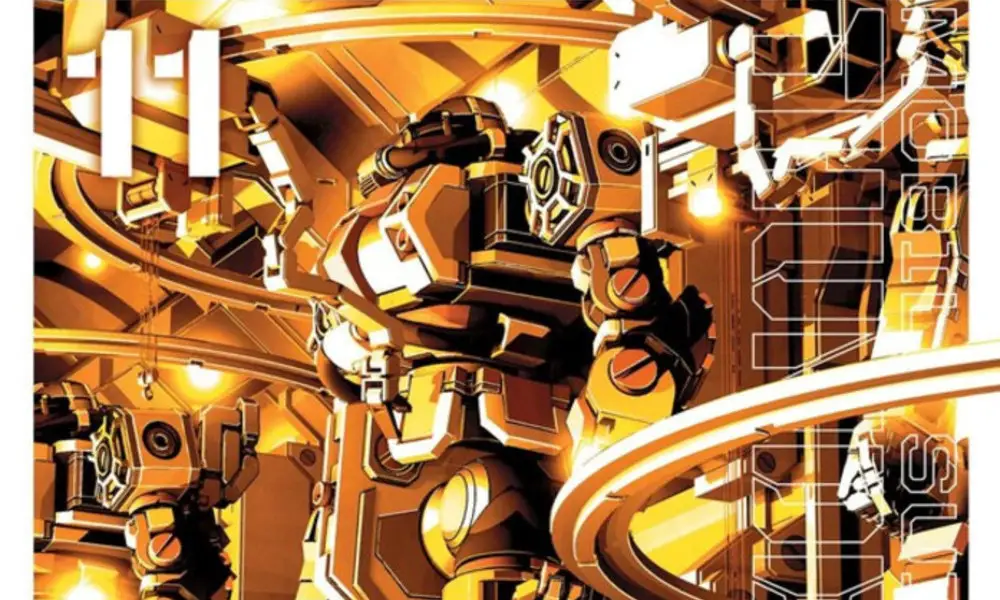[amazon_link asins=’197470646X’ template=’AiPTProductAd’ store=’aiptcomics-20′ marketplace=’US’ link_id=’844f839d-f24e-4af4-b1b5-00aabfe737ad’]
I didn’t start reading Mobile Suit Gundam Thunderbolt until the series was already several volumes in, but that hasn’t stopped it from keeping my attention ever since. If you’re looking for cool giant robots like I am then you won’t be disappointed by Yasuo Ohtagaki’s gorgeous renderings of them. If you’re looking for a solidly written war story, as I also am, you’re likely to be pleased on that front as well. Vol. 11 is out now and it features some major developments for Daryl, Karla, and their allies. Does this installment meet the high bar set by its predecessors?
Visually, this series continues to impress. As far as his depictions of warfare go, Ohtagaki displays the same strengths as usual: good textures, imposing mecha, and impressively rendered explosions. One of most memorable images in the book is a two-page spread of a mech finishing up a 360-degree swipe attack as its surrounded by other robots. It’s like a moment frozen in time as you can see the damage that’s been done to all the mech’s opponents; the panel takes place mere seconds after they were hit and they’re beginning to fall apart. Moments like this are really impactful, and though some of the volume’s action feels a bit stilted here and there it’s effective for the most part.
The backgrounds and nature imagery here are also lovely, thanks largely to the evocative shading. Ohtagaki does a great job setting various moods both in combat sequences and in quieter human moments. With that said, there’s still a whole world out there. The attention paid to detail when rendering large flocks of birds or flowing magma help give the sense that there’s an actual home these characters are fighting for.
Lovely as that world is, it’s the human elements of the story that are most intriguing. One such instance is a multi-page sequence of a character waking up and getting dressed. There’s no dialogue or narration for twenty-two panels in a row, but the way Ohtagaki hones in on specific objects and expressions effectively conveys the character’s emotions. There’s a lot of great development and personality in both the body language and the dialogue throughout the book, and even details like the various textures of characters’ hair feel well-done. Even new minor characters are effectively introduced via scenes that quickly convey how they interact with others and what they contribute to the plot.
One interesting aspect of the story is its repeated use of religious iconography, specifically Buddhism as practiced by the Nanyang Alliance. Any good war story should have more to convey than just gunfire and explosions, and there’s some heavy subtext here. Seeing figureheads of a religion so fundamentally concerned with the easing of suffering actively build war technologies causes one to think, even if only in passing, about how easily human convictions can be spun into justifications for atrocities. It’s worth noting that the Nanyang Alliance isn’t depicted as cartoonishly evil, and the force they stand against is literally referred to as a military-industrial complex, so no one’s totally pure here. Earlier on in the series I was a bit weary about the possibility of Buddhists being dehumanized in the manga, but from what I’ve seen thus far that’s not case.
My other main plot concern is the handling of Karla’s strange brand of amnesia. At the start of the volume she appears to think of herself as a child and refers to Daryl as “Daddy.” Later on in the story she regains her memory and returns to being Daryl’s lover, as she was pre-amnesia. Taken out of any other context the pair’s romantic scenes are quite nicely written, but there’s just a really bizarre and gross undercurrent to them when you remember that one of the characters was treating the other like a parent less than a hundred pages prior. This seems less like an intentional attempt to skirt around acknowledging unacceptable attractions (i.e. anime and manga protagonists falling for girls who look like children but are actually millennia-old dragons or some such nonsense) and more just like Ohtagaki didn’t fully think through the implications of these plot points.
All in all, Mobile Suit Gundam Thunderbolt Vol. 11 is unquestionably an interesting read. The artwork continues to be gorgeous, delivering human intimacy, remarkable nature imagery, and the franchise’s prerequisite big honking mechs. The story is also well-written for the most part, although some scenes get a bit stilted and there are gross undertones to the romance toward the end. I’d advise readers to know what they’re getting into beforehand, but this manga is definitely thought-provoking.
Join the AIPT Patreon
Want to take our relationship to the next level? Become a patron today to gain access to exclusive perks, such as:
- ❌ Remove all ads on the website
- 💬 Join our Discord community, where we chat about the latest news and releases from everything we cover on AIPT
- 📗 Access to our monthly book club
- 📦 Get a physical trade paperback shipped to you every month
- 💥 And more!













